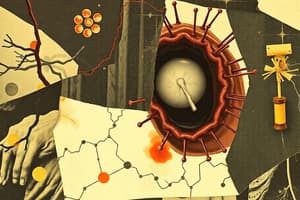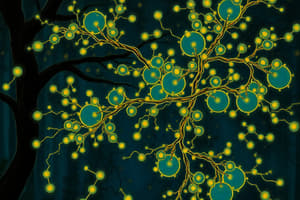Podcast
Questions and Answers
What shape are mitochondria?
What shape are mitochondria?
Sausage-shaped
What type of membrane surrounds the mitochondria?
What type of membrane surrounds the mitochondria?
- Double membrane (correct)
- Single membrane
- No membrane
- Triple membrane
The outer membrane of mitochondria is highly permeable.
The outer membrane of mitochondria is highly permeable.
True (A)
The inner membrane of mitochondria is less permeable and contains specific protein transporters.
The inner membrane of mitochondria is less permeable and contains specific protein transporters.
What is the primary function of the intermembrane space?
What is the primary function of the intermembrane space?
What are the invaginations of the inner membrane called?
What are the invaginations of the inner membrane called?
What does the mitochondrial matrix contain?
What does the mitochondrial matrix contain?
What process occurs in the mitochondrial matrix to generate ATP?
What process occurs in the mitochondrial matrix to generate ATP?
Mitochondrial DNA is inherited from both parents.
Mitochondrial DNA is inherited from both parents.
Cytochrome C is involved in which process?
Cytochrome C is involved in which process?
What theory suggests that mitochondria were once prokaryotic cells?
What theory suggests that mitochondria were once prokaryotic cells?
What is the main purpose of the electron transport chain?
What is the main purpose of the electron transport chain?
The Krebs cycle also known as the __________ cycle occurs in the mitochondrial matrix.
The Krebs cycle also known as the __________ cycle occurs in the mitochondrial matrix.
Study Notes
### Mitochondria Structure
- Sausage-shaped organelle
- Double membrane: outer and inner.
- Outer membrane
- Highly permeable
- Allows molecules to pass freely
- Contains pores
- Inner membrane
- Less permeable
- Contains specific protein transporters, tightly regulating what moves in and out
- Forms invaginations called cristae
- Intermembrane space
- Between outer and inner membranes
- Rich in proton ions (H+)
- Important for electron transport chain
- Cristae
- Invaginations of the inner membrane
- Increase surface area for metabolic reactions
- Mitochondrial Matrix
- Interior fluid of the mitochondria
- Contains mitochondrial DNA and ribosomes
- Site of many important metabolic reactions
Mitochondrial Membrane Functions
- Protein transport
- Mitochondria receives unfolded proteins from cytoplasm
- Proteins are transported via specialized channels: TOM (translocase of the outer membrane) and TIM (translocase of the inner membrane)
- Proteins are folded and activated in the matrix
- Miscellaneous transport of nutrients and ions
- Mitochondria transports molecules like carbohydrates, fatty acids, and amino acids across their membranes
- Essential for metabolic reactions occurring inside the mitochondria
- Electron transport chain
- Located in the inner membrane of the mitochondria
- Involves a series of protein complexes
- High-energy electrons are transported from NADH and FADH2 (produced during metabolic reactions) to these complexes
- Electrons flow down the chain, releasing energy that is used to pump protons into the intermembrane space
- Proton concentration gradient is created, allowing protons to flow back into the matrix via ATP synthase
- This flow generates ATP through oxidative phosphorylation
- Reactive oxygen species (ROS) can be a byproduct of electron transport
Mitochondrial Matrix Functions
-
Krebs cycle (also known as the citric acid cycle):
- Series of metabolic reactions occurring in the mitochondrial matrix
- Starts with acetyl-CoA (formed from pyruvate)
- Generates electron carriers (NADH and FADH2) and ATP
-
Other Metabolic Reactions
- Gluconeogenesis: Synthesis of glucose from other molecules (e.g. amino acids, glycerol)
- Fatty acid oxidation (beta-oxidation): Breaks down fatty acids into acetyl-CoA
- Urea cycle: Removes ammonia from the body, produced in the liver
Mitochondrial DNA and Ribosomes
-
Mitochondrial DNA
- Contains genes for mitochondrial proteins
- Maternal inheritance
- Makes RNA
-
Ribosomes
- Translate RNA into proteins
- Allows the mitochondria to produce some of its own proteins
Mitochondrial Matrix
- the mitochondrial matrix is the space enclosed by the inner membrane
- many metabolic reactions occur in the mitochondrial matrix:
- conversion of pyruvate to acetyl-CoA
- Krebs cycle
- beta oxidation of fatty acids
- urea cycle
- gluconeogenesis
- heme synthesis
- ketogenesis
Metabolic Reactions Location
- urea cycle occurs in both the mitochondria and the cytoplasm
- gluconeogenesis occurs in both the mitochondria and the cytoplasm
- heme synthesis occurs in both the mitochondria and the cytoplasm
Mitochondrial DNA
- mitochondrial DNA can replicate itself to make two mitochondria via a process called fission
- mitochondrial DNA can undergo transcription to produce RNA
- mitochondrial ribosomes (70S) translate RNA to synthesize proteins
- mitochondrial DNA encodes for about 15% of the proteins that the mitochondria needs to function
Apoptosis
- cytochrome C is a molecule located in the mitochondrial matrix
- cytochrome C can leak out during apoptosis
- leaked cytochrome C triggers apoptosis by activating caspases, which damage cell membranes and organelles
- bcl2 prevents cytochrome C from leaking out of the matrix
- apoptosis is programmed cell death
Endosymbiotic Theory
- the endosymbiotic theory suggests that mitochondria were once prokaryotic cells that were engulfed by eukaryotic cells
- mitochondria have their own DNA, ribosomes, and can replicate independently
Additional Notes
- the inner mitochondrial membrane is impermeable to most molecules
- the outer mitochondrial membrane is permeable to most small molecules
- the electron transport chain generates ATP via oxidative phosphorylation
- NADH and FADH2 carry electrons from the Krebs cycle to the electron transport chain
- the mitochondrial matrix has a higher concentration of protons than the intermembrane space
- the mitochondrial matrix is involved in a wide variety of metabolic reactions
Mitochondria Structure
- Sausage-shaped organelle with a double membrane
- Outer membrane is highly permeable, allowing molecules to pass freely through pores
- Inner membrane is less permeable with specific protein transporters that regulate movement
- Inner membrane forms invaginations called cristae
- Intermembrane space between the membranes contains a high concentration of protons (H+) and is essential for the electron transport chain
- Cristae increase the surface area of the inner membrane for metabolic reactions.
- Mitochondrial Matrix is the interior fluid containing mitochondrial DNA and ribosomes, where many crucial metabolic reactions take place.
Mitochondrial Membrane Functions
- Protein transport involves specialized channels: TOM (translocase of the outer membrane) and TIM (translocase of the inner membrane)
- Unfolded proteins from the cytoplasm are received by mitochondria and transported through these channels
- Proteins are then folded and activated within the matrix.
- Mitochondria transport nutrients and ions such as carbohydrates, fatty acids, and amino acids across their membranes, supporting the metabolic functions within the organelle.
- Electron transport chain is located in the inner membrane and comprises a series of protein complexes.
- High-energy electrons from NADH and FADH2, produced in metabolic reactions, are transported to these complexes.
- Electrons flow down the chain, releasing energy used to pump protons into the intermembrane space, creating a proton gradient.
- This gradient drives protons back into the matrix through ATP synthase, generating ATP via oxidative phosphorylation.
- Reactive oxygen species (ROS) can be produced as a byproduct of electron transport.
Mitochondrial Matrix Functions
- Krebs cycle (also known as the citric acid cycle) occurs in the mitochondrial matrix.
- Acetyl-CoA, formed from pyruvate, initiates the Krebs cycle, generating electron carriers (NADH and FADH2), and ATP.
- Other reactions in the matrix include:
- Gluconeogenesis: glucose synthesis from other molecules like amino acids and glycerol
- Fatty acid oxidation (beta-oxidation): breaks down fatty acids into acetyl-CoA
- Urea cycle: removes ammonia from the body, primarily in the liver.
Mitochondrial DNA and Ribosomes
- Mitochondrial DNA (mtDNA) encodes for proteins necessary for mitochondrial function.
- mtDNA is inherited maternally and is capable of producing RNA.
- Mitochondrial ribosomes translate RNA into proteins, allowing the mitochondria to synthesize some of its own proteins.
Mitochondrial Matrix
- Metabolic reactions occur within the mitochondrial matrix, including:
- conversion of pyruvate to acetyl-CoA
- Krebs cycle
- beta oxidation of fatty acids
- urea cycle
- gluconeogenesis
- heme synthesis
- ketogenesis
Metabolic Reactions Location
- The urea cycle and gluconeogenesis occur in both the mitochondria and the cytoplasm
- Heme synthesis takes place in both the mitochondria and the cytoplasm
Mitochondrial DNA
- Mitochondria replicate through fission, producing two mitochondria.
- Mitochondrial DNA undergoes transcription to produce RNA.
- Mitochondrial ribosomes (70S) translate RNA to synthesize proteins.
- mtDNA encodes for approximately 15% of the proteins necessary for mitochondrial function.
Apoptosis
- Cytochrome C resides in the mitochondrial matrix.
- During apoptosis, cytochrome C can leak out of the matrix, activating caspases that damage cell membranes and organelles.
- Bcl2 prevents the leakage of cytochrome C.
- Apoptosis is a form of programmed cell death.
Endosymbiotic Theory
- The endosymbiotic theory proposes that mitochondria originated as prokaryotic cells engulfed by eukaryotic cells.
- Mitochondria have their own DNA, ribosomes, and can replicate independently, supporting this theory.
Additional Notes
- The inner mitochondrial membrane is impermeable to most molecules.
- The outer mitochondrial membrane is permeable to most small molecules.
- The electron transport chain generates ATP via oxidative phosphorylation.
- NADH and FADH2 transport electrons from the Krebs cycle to the electron transport chain.
- The mitochondrial matrix has a higher proton concentration than the intermembrane space.
- The mitochondrial matrix is involved in a wide range of metabolic reactions.
Studying That Suits You
Use AI to generate personalized quizzes and flashcards to suit your learning preferences.
Description
Explore the fascinating structure and essential functions of mitochondria in this quiz. Learn about the unique characteristics of the outer and inner membranes, their roles in metabolic reactions, and the significance of cristae. Test your knowledge of mitochondrial protein transport mechanisms and more.




